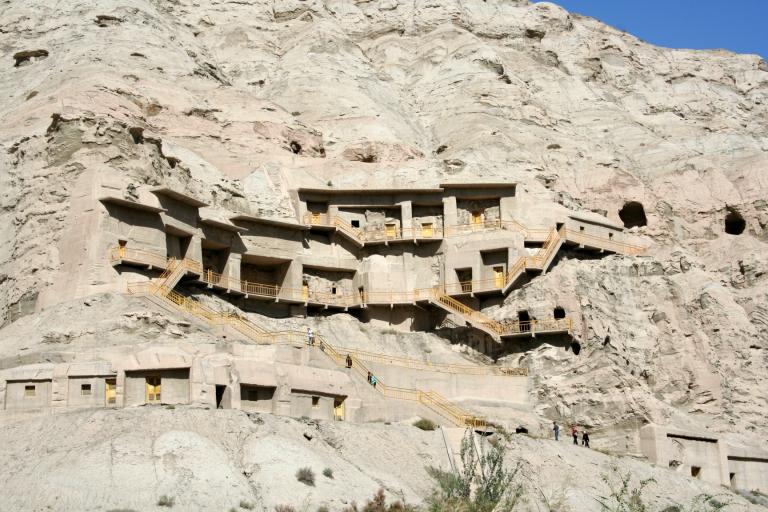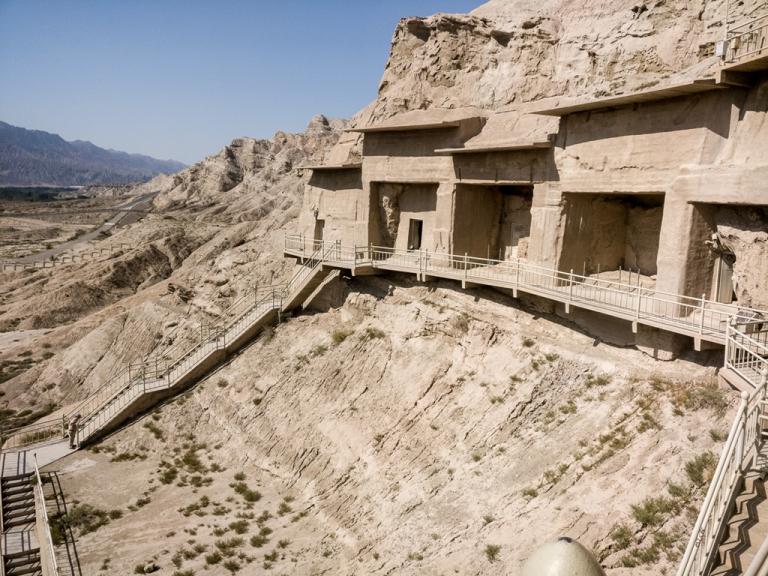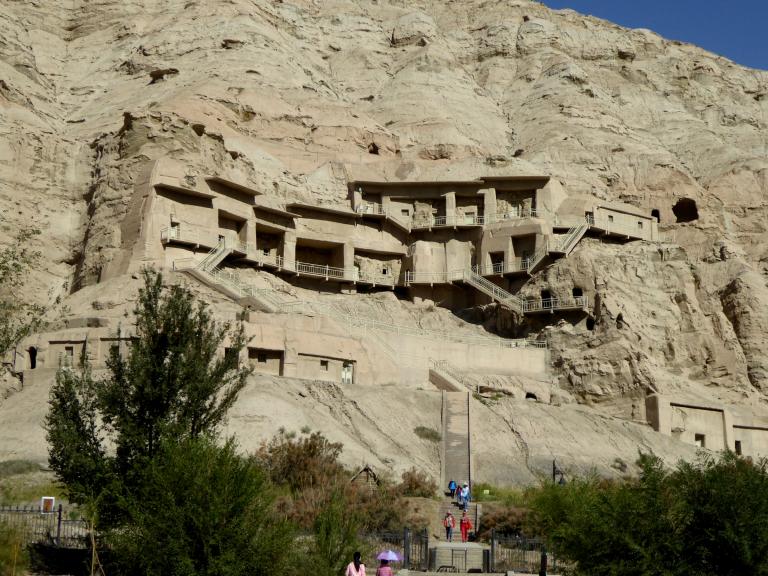Kizil Caves
6 min readThe Kizil Caves is the national key cultural relic protection site of China,a famous Buddhist holy shrine and a shining pearl on the Silk Road. Located at the foot of the Mingwu Dag Mountain in Baicheng County of today’s Akesu Area, the Muzati River(originated from the highest peak, Tomor Peak of the Mt. Tianshan) meanders eastwards from the south to bring infinite vigor and vitality to this small oasis. The grotto distantly faces the Querdage Mountain on the south bank of the river, and is 67km away from Kuche.
The forefathers decided to build the grotto here for some reasons.According to Buddhist sutras,a place for Buddhist monks to cultivate themselves shall be neither close to noisy towns in case of affecting their religious life, nor far away from the towns in case of breaking the human habitation to lose the guarantee for clothing and food. The geographic location here is appropriate, and natural conditions are advantageous, so Kizil is the ideal place for building the grotto.
Analyzed according to the historical records and the spread of the Buddhism in ancient Qiuci, the Kizil Caves was approximately built in the 3rd and 4th centuries or earlier; its flourishing period was in the 6th and 7th centuries. After the Tubo occupied Qiuci at the end of the 8th century, the grotto had been gradually abandoned. Large-scale construction of the grotto was stopped at that time, to say the least. The construction time in succession was as long as five or six hundred years.

The Kizil Caves is the westernmost one among China’s four major grottoes(the Dunhuang Caves, the Longmen Grottos, the Yungang Grottos and the Kizil Caves) as well as the earliest large-scale Thousand-Buddha Cave existing in China. As the largest Buddhist cultural site in Xinjiang, the Kizil Caves has cleaned and numbered 236 grottoes now, including the “Chaitya”for worshipping the Buddha and doing religious service, the vihara “Piahluo Cave”for the monks to retreat or give lectures, the “Arhat Grotto”for daily life of the monks, the”Dormitory”for burying bone ash, and warehouses for storing the food. Its completely preserved architectural pattern is rare in other grottoes.
The area of the preserved wall paintings in the Kizil Caves is nearly ten thousand square meters, so the wall paintings are mural treasures ranking only second to the wall paintings in the Dunhuang Grotto. Besides the Buddha figures, bodhisattvas, demi-gods and semi-devils, arhats, Buddhism biography stories, jataka stories, nirvana, apsaras and gigaku gods, the content of the wall paintings also includes a large number of folk pictures using landscape, birds, animals, human beings, production and living scenes as themes. Painters in the ancient Qiuci had superior skills, and the “wet drawing method”was their outstanding creation. The “wet drawing method”is characterized by directly drawing on mud walls, but not on white walls, using mineral pigments with covering power as well as using transparent pigments, not only coating flatly and emphasizing the most important point by elaboration, but also blooming on the bottom wall by water in a coloring process. This is the “wet drawing method”adopted by the painters in the ancient Qiuci, also known as an embossing technique. The painting “Qiuci King Worships the Buddha”in the numbered 69# grotto is a representative of the “wet drawing method”. The ancient painters showed historical charms and living scenes from about the 3rd century to the 13th century in ancient Xinjiang to us through the vivid pictures.These precious image data is of great importance to the study of the politics, cultures, religions, economies, military affairs, nationalities and customs inancient Xinjiang and the economic and cultural exchanges between China and western countries on the ancient Silk Road.
The jataka story paintings reflecting the classics of the Buddhism are the essence of the Kizil Caves. The jataka story paintings in the Kizil Caves not only are of high artistic level and unique, but also has a large quantity. The number of the jataka story paintings in the Kizil Caves is about 60 to 70 or more, which is more than two times of the total number (over 30 varieties) of the jataka story paintings in Dunhuang Grotto, the Longmen Grotto and the Yungang Grotto. In the numbered 17# cave known as the “Crown of the Story Painting”, the walls, grotto roof and niche flattering passages in the”Chaitya Grotto”are full of colorful wall paintings. On the roof, there is a jataka story saying”Bodhisattva holding the burning hands that wrapped around by the thin white felt, pointed out the way forward”. Although the religious features aredistinctive, the close relationship between the Buddhist monks and the caravans on the ancient Silk Road can be still seen. The caravans needed the Buddhist monks to pray for safeness for them, and the Buddhist monks not only needed the charity from the caravans, but also accompanied large-scale caravans to spread the Buddhist sutras or pursue Buddhist doctrines.

The wall paintings in the Kizil Caves not only has a lot of Buddhist images, but also has folk wall paintings reflecting the farming, animal husbandry, hunting, vehicles and boats, and buildings. The “Farming Image”in the numbered 175# grotto and the”Qiuci Music and Dance Figure”in the numbered 38# grotto are the masterpieces reflecting the folk life. By the A.D.1st century, approximately in the period of the Emperor Ming of the Eastern Han Dynasty, the Buddhism had been spread to Xinjiang through the Silk Road. By the 13th and 14th centuries with the Islam replacing the Buddhism, the Buddhism had been prosperous for over one thousand years. By the 4th century, the Buddhism had been prosperous in the Qiuci kingdom. At that time,a great number of tastefully decorated Buddhist temples and Thousand-Buddha Caves on a grand scale were built. In the 7th century, the Buddhism in Qiuci reached the heyday. According to the Records of the Western Regions of the Great Tang,”there were more than one hundred Buddhist temples and more than five thousand monks in Qiuci, and they always held Buddha meetings for more than ten days at the Autumnal Equinox every year..”A great number of the wall paintings in the Kizil Caves vividly reveal an actual situation that the kings in Qiuci believed in Buddhism for generations.
The wall paintings in the Kizil Caves were not only influenced by the Han culture, but also absorbed foreign cultures and arts, and further created by the intelligence of the painters in Qiuci. The wall paintings in the Kizil Caves gathered the intelligence and wisdom of people of all nationalities. Dug in the initial period of the Chinese Grotto Art and located in the communication hub of the Silk Road, the Kizil Caves is a witness that the Buddhism and relative arts were transmitted to the mainland through it. Since the foundation of People’s Republic of China in 1949, the people’s government has attached great importance to the protecting and studying of the Kizil Caves. In 1961, the Kizil Caves was listed as one of the first batches of the national key cultural relic protection sites to protect well. Nowadays, the Kizil Caves is a research center of Xinjiang Buddhism art and a domestic and international famous tourist attraction.
In recent years, the grottoes of the Kizil Caves have been reinforced through rescue and maintenance, and past wooden ladders have been replaced by new concrete trestle roads and steps, which not only brings great convenience to visitors, but also provides guarantee for their safety.
Reposing at the foot of the Mingwu Dag Mountain, the Kizil Caves is still footless and quiet. It is a wonderfully dramatic history itself, witnessing the vicissitudes of life, telling Buddhism-spreading stories, Buddhism-worshiping stories in the ancient Qiuci and stories occurring on the Silk Road. The stories are impressive, vivid and attractive.









